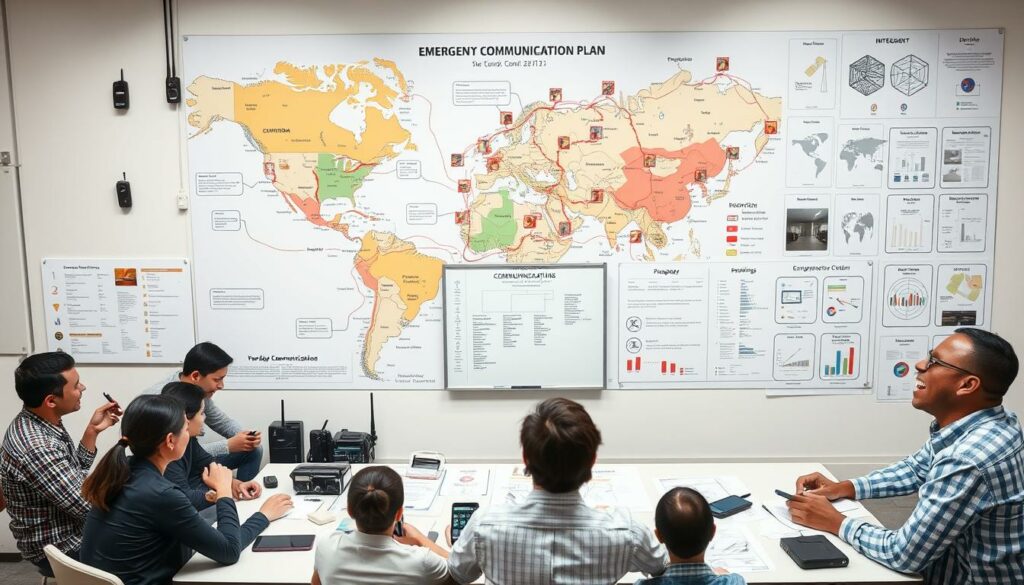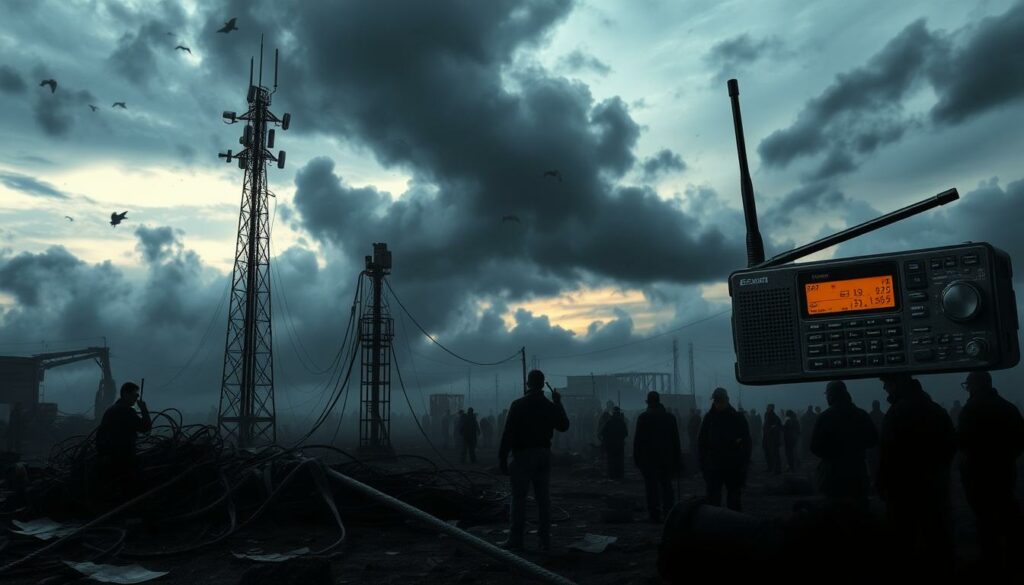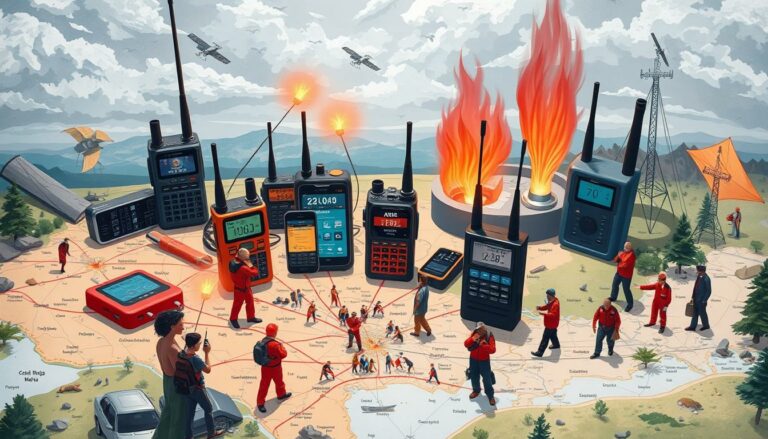Emergency communication strategies are key to keeping people connected in emergencies. They help communities stay safe and united. Clear, simple information is vital in times of crisis. It builds trust, manages information, and helps families find each other.
There are many tools for communication, each with its own strengths and weaknesses. Using different channels can help reach more people, up to 70%. This includes two-way radios, mass notification systems, and social media.
Studies show that having plans in place can cut response times by 30%. Regular training also boosts a community’s ability to handle emergencies by 44%. This shows how important being ready is.
Key Takeaways
- Multi-channel communication significantly reduces the risk of miscommunication during emergencies.
- Text messages, with a 98% open rate, are reliable during network congestion.
- Communities with preparedness training are better equipped to handle crises.
- Pre-established protocols can improve response times by up to 30%.
- Individuals often lack a personal communication plan, highlighting an area for improvement.
Importance of Emergency Communication
Emergency communication is key in disaster management and public safety. It’s about sharing the right message at the right time. Knowing its value helps us prepare and manage crises better.
Understanding its Role in Crisis Situations
In a crisis, quick and clear communication is vital. It can prevent panic and help everyone act together. 911 calls are a prime example of how critical this is.
The Impact on Public Safety
Good public safety communication is vital for informing and coordinating. It keeps communities safe and secure. Governments rely on these systems for teamwork and planning.
Effective Information Dissemination
Sharing info in emergencies uses many channels like social media and community meetings. Keeping systems like NIMS and ICS up to date is important. Planning must think about who needs to know and how to reach them.
| Aspect | Importance |
|---|---|
| 911 Calls | Critical lifeline in emergencies |
| Natural Disasters Frequency | Increasing need for robust systems |
| Collaboration & Interoperability | Essential for effective response |
| Next Generation 911 (NG911) | Enhanced communication capabilities |
| Public Safety Stakeholders | Dependence on resilient communication |
| Priority Services | Ensure critical communication delivery |
| Rural Communities | Development of crisis plans critical |
| Emergency Alert Systems | State authorities conduct monthly tests |
Types of Emergency Communication Systems
Effective emergency communication systems are key to safety in crises. They range from traditional two-way radios to modern mass notification systems and social media. Knowing how each works can greatly improve response times and safety.
Two-Way Radios and Their Benefits
Two-way radios are essential for emergency communication. They offer reliable connection in remote areas where other methods fail. For example, the Midland GXT1000VP4 has a range of 36 miles, helping responders stay in touch without cell towers or internet.
This is vital during power outages. Dead cell phones and busy cell towers can block communication.
Mass Notification Systems Explained
Mass notification systems quickly send important messages to many people. They use phone calls, emails, texts, and loudspeakers. This ensures messages are clear and fast.
For instance, during the Virginia Tech massacre, quick alerts could have saved lives. The delay showed how critical fast communication is.
Social Media as an Emergency Tool
Social media is now a key tool for sharing info and feedback in emergencies. Sites like Twitter and Facebook help FEMA share updates quickly. During the 2012 Wisconsin Sikh temple shooting, victims used texts for help, showing social media’s value.
Also, during Hurricane Sandy, millions lost power. This highlighted the need for various communication methods, including social media.
| Communication Channel | Advantages | Disadvantages |
|---|---|---|
| Two-Way Radios | Reliable over long distances, does not rely on cell towers | Limited to range, requires same frequency |
| Mass Notification Systems | Instantly reach large audiences, multiple channels | May be ineffective if power/internet is down |
| Social Media | Real-time updates, widespread reach | Subject to misinformation, requires internet access |
Using different emergency communication systems together helps authorities send timely, accurate info. This mix of two-way radios, mass notification systems, and social media ensures effective communication in any situation.
Preparing Your Emergency Communication Plan
It’s key to have a solid emergency communication plan ready. This plan should include training, getting everyone involved, and clear roles. It must be flexible to reach all parts of the community when usual ways of talking break down.

Key Components of an Effective Plan
There are important parts to make an emergency plan work well:
- Preparation: Regular training is a must. It makes sure everyone knows their part.
- Multiple Communication Methods: Using texts is smart because they use less bandwidth than calls.
- Redundancies: Having backup systems and extra ways to talk keeps connections going.
- Emergency Contact Information: Keep paper copies of important numbers handy.
- Meeting Places: Pick safe spots for everyone to meet, including those with disabilities.
- Technology Tips: Teach how to save phone battery, like lowering brightness and using airplane mode.
Involving Stakeholders and Community
Getting everyone involved is key for a good emergency plan. Tailor messages for different groups, like security teams and remote workers. Having a team with clear roles is also important.
Engage with the community through forums and drills. For example, practice your Family Emergency Communication Plan often. Talk about its importance with your family.
Training for Emergency Preparedness
Training is vital to make sure everyone knows what to do. This includes:
Emergency plans only work if everyone involved knows what to do. It’s like a musical performance; everyone must know their roles to avoid chaos.
Do practice sessions at least once a year or when your family info changes. Make sure stakeholders are part of these sessions. Also, teach handy tips like memorizing phone numbers and knowing when to call 911.
Technology in Emergency Communication
Emergencies need quick and clear communication. New tech makes this possible. It makes information sharing faster, more reliable, and clearer.
Mobile Apps for Crisis Management
Mobile apps have changed how we handle emergencies. They let us communicate in real-time. Features like GPS and instant alerts are key.
There’s been a big increase in app downloads for emergencies. This shows how important they are.
Utilizing SMS Alerts for Rapid Updates
SMS alerts are essential for fast crisis communication. They send messages quickly to many people. This ensures everyone gets important info fast.
Studies back this up. They say using SMS and other channels helps more people get messages.
The Evolution of Communication Tools
Communication tools have changed a lot. They’ve moved from old systems to digital ones. This makes sending emergency messages better.
Old systems had delays and mistakes. Now, we have tools like Push-To-Talk radios and GIS. They let us share data and map locations in real-time.
| Aspect | Traditional Systems | Modern Systems |
|---|---|---|
| Speed | Slower, prone to delays | Immediate and real-time |
| Reliability | Limited, often disrupted | Enhanced, resilient |
| Clarity | Susceptible to miscommunications | Clear and concise |
The progress in emergency communication technology is clear. Today’s systems are more reliable and efficient. This helps communities prepare and respond to emergencies better, keeping everyone safe and getting help quickly.
Best Practices for Emergency Messaging
Following emergency messaging best practices is key for keeping people safe in crises. Clear and quick messages help reduce panic and improve response times.
Crafting Clear and Concise Messages
In emergencies, it’s vital to send concise emergency messages that are simple and clear. These messages should tell what happened, where, and what to do. Research shows that clear, timely info builds trust and encourages quick action.
Timing is Everything: When to Communicate
When you send messages matters a lot. Emergency alerts should go out fast to get the right response. People often check trusted sources before acting. So, sending updates quickly helps clear up confusion and gets people moving faster.
Using Multiple Channels for Broader Reach
Using multi-channel communication helps more people hear the message. A mix of mobile alerts, social media, and mass notifications works well. For example, mass systems can reach up to 100,000 people in under 10 minutes. This way, more people get the message, even in areas with poor reception.
In short, emergency messaging best practices mean making messages short and clear, sending them on time, and using many ways to share them. By doing this, families and communities can get ready and respond better in emergencies.
Challenges in Emergency Communication
Emergency communication faces many challenges that can slow down response and coordination in crises. It’s key to tackle these issues to ensure smooth communication and efficient emergency management.
Overcoming Technology Limitations
Technology issues are a big hurdle in emergency communication. Problems like equipment failures, location issues, and old systems can cause delays and misunderstandings. For instance, 81% of emergency managers have seen communication failures during crises.
To beat these tech hurdles, agencies need to invest in dependable communication tools. Regular upkeep and updates are also vital. Plus, training with neighboring departments can boost communication by 50% during joint efforts.
Addressing Language Barriers
Language barriers are another challenge in emergency communication. Clear language is essential, but studies show about 70% of people might not get emergency messages right, like during active shooter events. Using multilingual alerts and community translators can help.
This ensures everyone, including marginalized groups, gets and understands important info.

Managing Misinformation in Emergencies
It’s vital to tackle misinformation in emergencies to keep public trust and ensure people follow instructions. Unchecked rumors can cut trust in health messages by 30%. This shows the need for active misinformation management.
Regular updates, being open, and working with trusted sources can fight misinformation. Training emergency responders to spot and fix false info quickly is also key to keeping emergency messages reliable.
Real-World Examples of Effective Communication
Looking at events like Hurricane Katrina and the COVID-19 pandemic shows how emergency communication has grown. We’ve learned a lot from past crises. Modern innovations have changed how we respond to disasters.
Case Study: Hurricane Katrina Response
Hurricane Katrina showed big challenges in disaster response, mainly in communication. The slow and poor communication made things worse. But, it also pushed for better emergency plans.
Many groups updated their communication plans, using new tech. This disaster showed the need for strong, multi-channel systems before crises hit. It set a new standard for disaster response.
Lessons Learned from the COVID-19 Pandemic
The COVID-19 pandemic showed how key clear info is. Governments and health groups had to share updates fast. This was key for safety and following health rules.
Marriott International faced big challenges, leading to big cuts and layoffs. Their CEO, Arne Sorenson, made a heartfelt video message. It was praised for its honesty and emotional touch. The pandemic showed the value of honest and timely communication.
Innovations from Recent Natural Disasters
Recent disasters have led to new ways to respond. Tech has changed how we share info in emergencies. Using social media and mobile apps for updates is now common.
These tools help get accurate info to people fast. This reduces the danger of false info. SMS alerts are also used for quick updates. They can save lives by getting info to people quickly.
In short, disaster response has evolved a lot. From Katrina to COVID-19 and new tech, we see the need for strong emergency systems. These examples show we must keep improving and using new tech and methods. This helps us prepare for the future.
Training and Drills for Effective Communication
Regular training for emergency communication is key to a smooth response in crises. Getting the community involved in training boosts everyone’s readiness. Drills help us learn from real scenarios and find ways to improve.
Importance of Regular Practice Sessions
Regular practice is essential. It makes sure everyone knows how to use communication tools. Doing drills often helps responders and the community feel more confident and ready for emergencies.
Engaging the Community in Training
Getting the community involved in training is vital. When locals join drills, they help keep themselves and others safe. Their input also helps make training better and more relevant.
Evaluating Responses and Improving Strategies
Checking how well we respond is a big part of training. After drills, we analyze what worked and what didn’t. Using tools like the Hotwash Comment Card helps us hear from everyone. This way, we can make our communication plans stronger.
| Aspect | Tools and Resources | Benefits |
|---|---|---|
| Training Frequency | Regular Practice Sessions | Increased Familiarity and Confidence |
| Community Engagement | Involving Local Residents | Enhanced Awareness and Feedback |
| Response Evaluation | Hotwash Comment Cards | Identifying Strengths and Gaps |
| Continuous Improvement | Feedback Mechanisms | Refined Communication Strategies |
Future Trends in Emergency Communication
The world of emergency communication is changing fast. AI and smart technology are leading this change. They help us deal with new threats better. They make our responses to emergencies faster and clearer.
The Role of Artificial Intelligence
AI has made a big difference in emergency calls. It cuts down the time it takes to handle calls by 50%. It also makes reviews faster, up to ten times quicker than before.
AI can understand over 100 languages in just 10 seconds. This saves a lot of time for people who don’t speak English. It makes emergency help quicker and more accurate.
Integrating Smart Technology Solutions
Smart technology is key to better emergency systems. For example, Intrado handles over 410 million transactions every year. Thanks to AI, they’ve become 70% more efficient.
Adding video surveillance helps us understand situations better. Real-time data from IoT devices also helps us respond faster. But, getting these technologies approved is hard because of strict rules. Yet, with 5G, communication will get even better.
Preparing for Evolving Threats and Risks
We need to keep up with new threats in emergency communication. Systems like Edwards’ Genesis LED Mass Notification send messages clearly. They even get better marks than “excellent” for clarity.
Keeping field devices connected is key for good communication. AI also cuts down on mistakes, making information more reliable. By using these technologies, we can get ready for future emergencies better.
Source Links
- https://www.buffalorestoration.com/article/emergency-communication-strategies-staying-connected-during-crises
- https://www.fema.gov/cbrn-tools/key-planning-factors-chemical-incident/kpf3/7
- https://www.cisa.gov/news-events/news/resilient-together-highlighting-importance-emergency-communications
- https://www.ruralhealthinfo.org/toolkits/emergency-preparedness/3/public-safety
- https://en.wikipedia.org/wiki/Emergency_communication_system
- https://terrafrma.com/blogs/news/your-guide-to-choosing-an-emergency-communication-system-for-disaster-events
- https://www.adjustersinternational.com/resources/news-and-events/top-10-communication-methods-in-a-disaster-setting/
- https://www.ready.gov/sites/default/files/2020-03/family-emergency-communication-planning-document.pdf
- https://www.alertmedia.com/blog/emergency-communications-plan/
- https://blog.networkinnovations.com/modern-technologies-in-emergency-communications
- https://www.dhs.gov/science-and-technology/news/2024/04/15/interoperability-key-effective-emergency-communications
- https://911cellular.com/blog/stay-connected-the-importance-of-emergency-communication-systems/
- https://training.fema.gov/emiweb/is/is242b/student manual/sm_03.pdf
- https://www.cisa.gov/emergency-communications-guidance-documents-and-publications
- https://911cellular.com/blog/emergency-communication-systems/
- https://basecampconnect.com/5-emergency-communication-challenges-emergency-responders-face/
- https://sbccimplementationkits.org/sbcc-in-emergencies/learn-about-sbcc-and-emergencies/emergency-sbcc-challenges-and-strategies/
- https://brandfolder.com/resources/crisis-management/
- https://www.contactmonkey.com/blog/crisis-communication-case-studies
- https://www.cisa.gov/safecom/training-and-exercises
- https://preparedex.com/essential-emergency-drills-for-the-workplace/
- https://www.linkedin.com/advice/3/heres-how-you-can-effectively-communicate-z86kc
- https://www.intrado.com/blog/shaping-the-future-of-emergency-communications-ai-innovations-trends-in-2024
- https://www.sdmmag.com/articles/102620-beyond-alerts-the-latest-trends-in-emergency-communications

